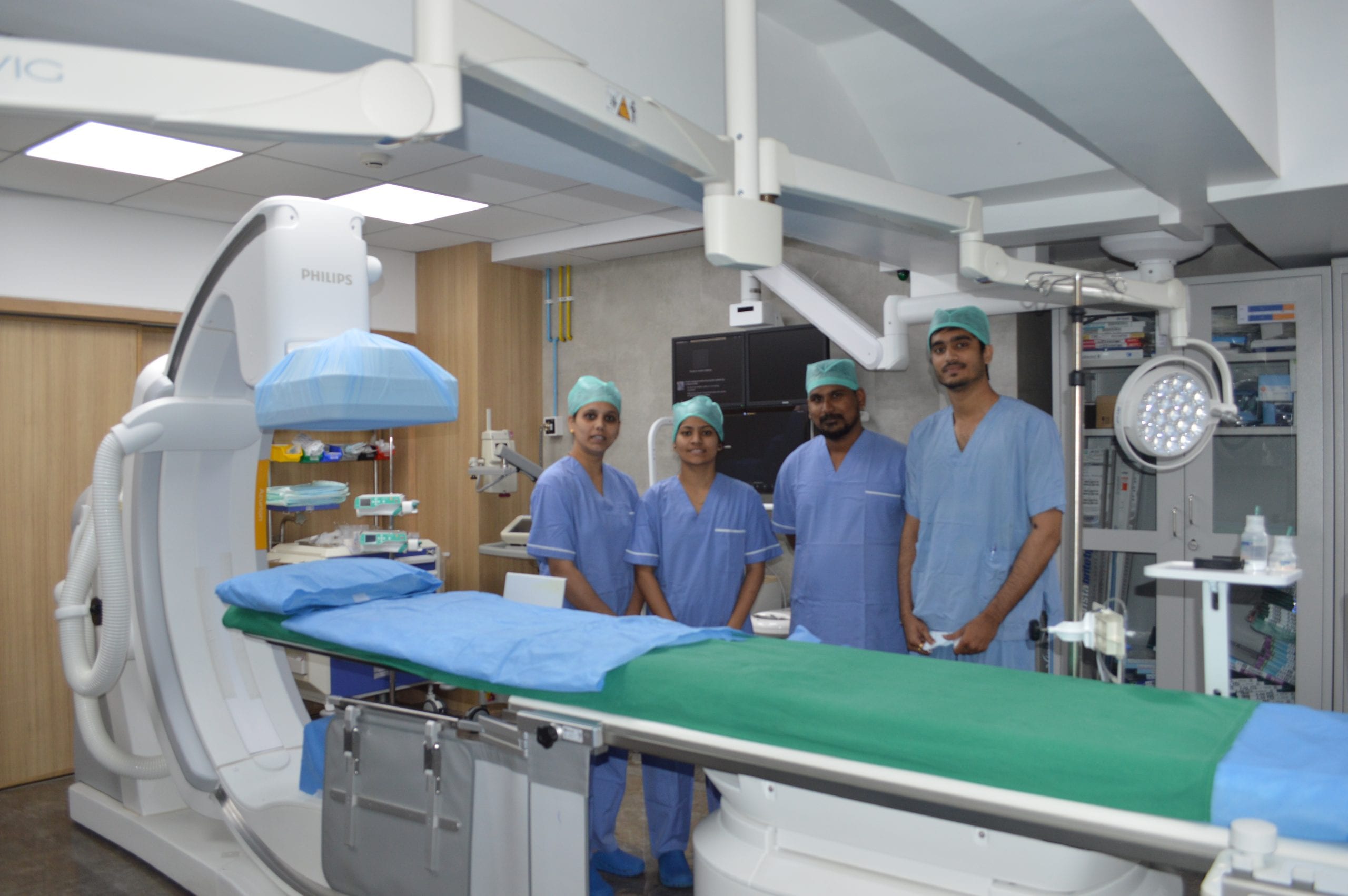Angiography

Coronary artery disease takes place when an upsurge of plaque that is fatty deposits, cholesterol and calcium get stuck to the walls of the arteries, causing narrowing and blockages, therefore reducing the flow of blood to the heart Such kind of blockages often result in pain known as angina. If the disease goes untreated, clots may form, resulting in a heart attack.
Following are risk factors for coronary artery disease:
- History of heart disease in family
- Obesity
- A diet containing a large amount of saturated fats
- High cholesterol
- Inactivity
- Unstable diabetes
- Smoking
- High blood pressure
Coronary angiography is a diagnostic process that is performed for detecting problems with the heart and the blood vessels.
Angioplasty is a surgical process where a special balloon is put – in for opening the artery at the point of blockage, to improve the flow of blood to the heart. If your doctor has recommended angioplasty, then this process might include stents and not might not. A stent is a stretchy wire mesh tube that is inserted into the expanded artery for keeping it open and allowing the flow of blood.
Stents are of two types:
- Plain metal variety, mostly used in acute situations
- The drug-release type that disperses the drug while in place for assisting in dilating the artery
Angiography is not only an all-encompassing process, but also the most conclusive tool for diagnosing the suspected heart disease and also find out the option for the best treatment. The expansion of the arteries that are blocked through angioplasty and also keeping the arteries open with stents brings in improvement in the flow of blood to the heart, which reduces the risk of heart attack and irregular heart rhythms.
Most of the times, Angiogram and angioplasty both the procedures are undertaken as day procedures in a specialized day surgery or cardiac catheter laboratory. After the surgery, an overnight stay at the hospital is required where stents are inserted.
The time that is needed in this process varies according to the condition an individual, but angiogram generally takes around 30 to 45 minutes, with approximately four four hours of the time of recovery after the process.
Angioplasty and an insertion of the stents might take about a half an hour’s time up to many hours which depends on the nature and extent of the coronary disease.
All concerned health care professionals are involved in the process, such as:
- Cardiologist
- Anesthetist (depends on the patient’s medical history)
- Pathologist (for blood tests)
- Specialized nurses (For assistance in the process and in the patient’s recovery)
The specialist is required to provide detailed advice on the preparation that is required in the case of a particular patient but the general preparation can be:
- One is required to fast that is should not eat or drink anything for around six hours prior to the process
- One should seek medical advice about the prescribed medications before the process
After angiogram, the patient is monitored while in the recovery area before given a discharge. If the process was of angioplasty/stents, one has to stay overnight, during which the patient is closely observed. In both the cases, the patient must have someone to accompany since one is not a condition to drive.
The doctor discusses the preliminary results of the angiogram before the patient is discharged. There is discussion about the instructions included after the day surgery or about any side effects that you might experience at home. Sometimes, the use of clot-preventing medicines are also prescribed after the process.
Angioplasty

Coronary Angioplasty is a medical procedure used to restore the blood flow through a blocked artery. In this non-surgical procedure, a thin tube with a balloon is inserted to expand the site of blockage in the coronary artery. It is also referred to as PTCA (procedure transluminal coronary angioplasty).
Angioplasty is a non-surgical procedure devised to unclog the blocked arteries. This procedure is carried out in a cardiac catheterization laboratory. This stenting is a device used to open the clogged arteries to restore blood flow.
The procedure of angioplasty can be conducted for broadening blockage in several blood vessels of the body. If it is being done for coronary blood vessels, it is known as coronary angioplasty. The process of unclogging blockage in other blood vessels is known as carotid artery.
A patient is asked to drink lots of water to help flush away the iodine contrast dye from the body system. On the site of insertion, a sandbag or pressure bandage is placed to prevent the bleeding. You’ll be asked to take rest for next few hours.
The doctor will talk to you about the amount of blockage eliminated from the artery and the possibility for the return of symptoms, necessary medications and changes to be implemented in the daily schedule.
You should call your doctor if:
- Insertion site bleeds
- Excessive chest pain
- Numbness in the arm & leg of the insertion side.
- Swelling increases
- You feel any fever or signs of infection
Following are the risks involved in the procedure of angioplasty:
- Bursting of the artery due to unsustainable high pressure
- Kidney problem due to the iodine contrast dye in X-rays
- Restenosis or re-blockage of the blood vessels
Our Outcome on Cathlab Procedure
SR NO | NAME OF PROCEDURE | NO OF PROCEDURE | COMPLICATION | MORTALITY | |||||||||||||||||
| NOV. TO DEC 2018 | JAN. TO DEC. 2019 | JAN. TO DEC. 2020 | JAN. 2021 | FEB. 2021 | MARCH. 2021 | APRIL. 2021 | MAY. 2021 | Jun-21 | TOTAL | NOV. TO DEC 2018 | JAN. TO DEC. 2019 | JAN. TO DEC. 2020 | JAN. 2021 | FEB. 2021 | MARCH. 2021 | APRIL. 2021 | MAY. 2021 | Jun-21 | |||
| 1 | CAG | 24 | 332 | 386 | 46 | 53 | 59 | 37 | 41 | 32 | 1010 | 0 | 0 | 0 | 0 | 0 | 0 | 0 | 0 | 0 | 0 |
| 2 | PTCA | 6 | 184 | 337 | 31 | 34 | 32 | 31 | 30 | 31 | 716 | 0 | 2 | 0 | 0 | 0 | 0 | 0 | 0 | 0 | 0 |
| 3 | PPI | 0 | 5 | 7 | 0 | 0 | 0 | 0 | 1 | 1 | 14 | 0 | 0 | 0 | 0 | 0 | 0 | 0 | 0 | 0 | 0 |
| 4 | TPM | 0 | 2 | 2 | 0 | 0 | 0 | 0 | 1 | 0 | 5 | 0 | 0 | 0 | 0 | 0 | 0 | 0 | 0 | 0 | 0 |
| 5 | BMV | 0 | 1 | 0 | 1 | 0 | 0 | 0 | 0 | 0 | 2 | 0 | 1 | 0 | 0 | 0 | 0 | 0 | 1 | 0 | 0 |
| TOTAL | 1747 | 4 | |||||||||||||||||||
